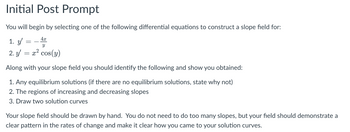You will begin by selecting one of the following differential equations to construct a slope field for: 1. y' 2. y' x² cos(y) Along with your slope field you should identify the following and show you obtained: 1. Any equilibrium solutions (if there are no equilibrium solutions, state why not) 2. The regions of increasing and decreasing slopes 3. Draw two solution curves - 4x
You will begin by selecting one of the following differential equations to construct a slope field for: 1. y' 2. y' x² cos(y) Along with your slope field you should identify the following and show you obtained: 1. Any equilibrium solutions (if there are no equilibrium solutions, state why not) 2. The regions of increasing and decreasing slopes 3. Draw two solution curves - 4x
Advanced Engineering Mathematics
10th Edition
ISBN:9780470458365
Author:Erwin Kreyszig
Publisher:Erwin Kreyszig
Chapter2: Second-order Linear Odes
Section: Chapter Questions
Problem 1RQ
Related questions
Question
Graphing First Order Linear D.E.'s
work on problem number 2 ( y'=x^2cos(y) )on the picture please! please show all your work and upload picture of all your work!!
Include the following:
- Evaluation of one of the questions above along with a brief explanation of which method you used.
- Make sure you show all of your work.

Transcribed Image Text:Initial Post Prompt
You will begin by selecting one of the following differential equations to construct a slope field for:
1. y'
2. y = x² cos(y)
Along with your slope field you should identify the following and show you obtained:
1. Any equilibrium solutions (if there are no equilibrium solutions, state why not)
2. The regions of increasing and decreasing slopes
3. Draw two solution curves
=
4x
Y
Your slope field should be drawn by hand. You do not need to do too many slopes, but your field should demonstrate a
clear pattern in the rates of change and make it clear how you came to your solution curves.
Expert Solution
This question has been solved!
Explore an expertly crafted, step-by-step solution for a thorough understanding of key concepts.
This is a popular solution!
Trending now
This is a popular solution!
Step by step
Solved in 4 steps with 10 images

Follow-up Questions
Read through expert solutions to related follow-up questions below.
Follow-up Question
Graphing First Order Linear D.E.'s
Please read the instructions on the picture and work on problem number 2!
work on problem number 2 ( y'=x^2cos(y) )on the picture please! please show all your work and upload picture of all your work!!
Include the following:
- Evaluation of one of the questions above along with a brief explanation of which method you used.
- Make sure you show all of your work.

Transcribed Image Text:Initial Post Prompt
You will begin by selecting one of the following differential equations to construct a slope field for:
1. y'
2. y = x² cos(y)
Along with your slope field you should identify the following and show you obtained:
1. Any equilibrium solutions (if there are no equilibrium solutions, state why not)
2. The regions of increasing and decreasing slopes
3. Draw two solution curves
=
4x
Y
Your slope field should be drawn by hand. You do not need to do too many slopes, but your field should demonstrate a
clear pattern in the rates of change and make it clear how you came to your solution curves.
Solution
Recommended textbooks for you

Advanced Engineering Mathematics
Advanced Math
ISBN:
9780470458365
Author:
Erwin Kreyszig
Publisher:
Wiley, John & Sons, Incorporated

Numerical Methods for Engineers
Advanced Math
ISBN:
9780073397924
Author:
Steven C. Chapra Dr., Raymond P. Canale
Publisher:
McGraw-Hill Education

Introductory Mathematics for Engineering Applicat…
Advanced Math
ISBN:
9781118141809
Author:
Nathan Klingbeil
Publisher:
WILEY

Advanced Engineering Mathematics
Advanced Math
ISBN:
9780470458365
Author:
Erwin Kreyszig
Publisher:
Wiley, John & Sons, Incorporated

Numerical Methods for Engineers
Advanced Math
ISBN:
9780073397924
Author:
Steven C. Chapra Dr., Raymond P. Canale
Publisher:
McGraw-Hill Education

Introductory Mathematics for Engineering Applicat…
Advanced Math
ISBN:
9781118141809
Author:
Nathan Klingbeil
Publisher:
WILEY

Mathematics For Machine Technology
Advanced Math
ISBN:
9781337798310
Author:
Peterson, John.
Publisher:
Cengage Learning,

